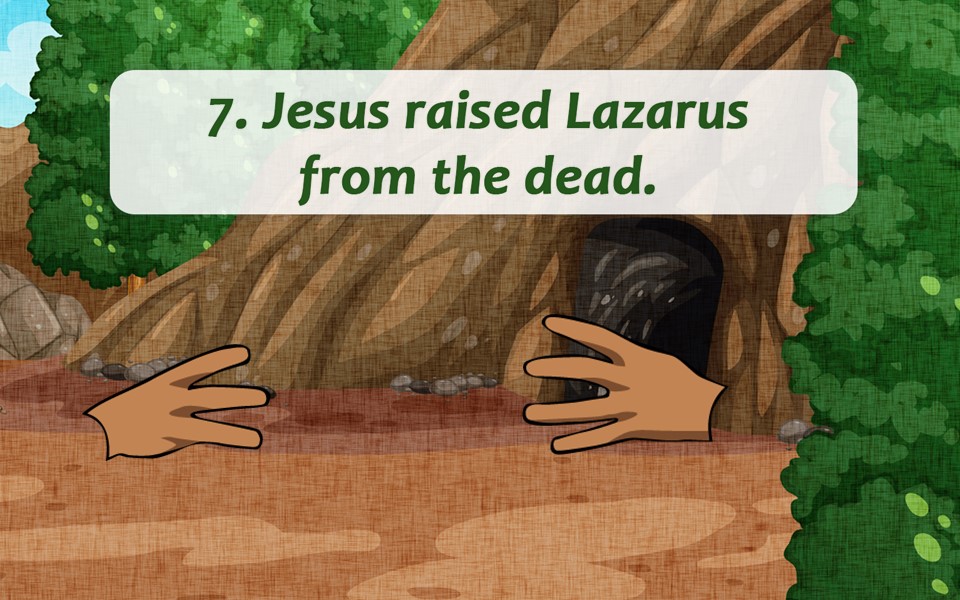7. Jesus Raised Lazarus from the Dead
John 11:1-46
Large crowds were constantly following Christ anxious to see miracles, and many viewed Him as a type of celebrity. However, Jesus also enjoyed some true friendships that were intimate and close. One of these dear families who knew Jesus personally was a sibling group who lived in Bethany. Because of their proximity to Jerusalem, it seems that Jesus often stayed with Martha, Mary, and Lazarus as He journeyed back and forth. John tells us that He loved these three dearly, and it’s clear that they loved Him dearly, too. Mary was the one who had anointed Christ with expensive ointment and wiped his feet with her hair, although this refers to an event after this current super sign.
Lazarus became seriously ill, so the sisters immediately sent word to Jesus knowing how much He cared for Lazarus. When Jesus received the news, He made a very interesting statement. He told His disciples that the illness wouldn’t lead to death, but was intended to bring God glory. Even more interesting, John tells us that because Jesus loved these three, He waited two days before going to them.
The disciples might have thought He would just heal him from afar as He had done before. Or, they might have thought, Jesus knows that he will get better on his own. When Christ told them that they would be returning to Judea (the place where the religious leaders were plotting to kill Him) they were surprised. They didn’t understand Christ’s wording about his death or His purpose to raise Him up.
Martha and Mary also did not understand Jesus’ delay. Upon hearing that He was approaching the town, Martha hurried out to meet Him. Being filled with sorrow tinged with faith in Christ, the following conversation takes place:
Martha said to Jesus, “Lord, if you had been here, my brother would not have died. But even now I know that whatever you ask from God, God will give you.” Jesus said to her, “Your brother will rise again.” Martha said to him, “I know that he will rise again in the resurrection on the last day.” Jesus said to her, “I am the resurrection and the life. Whoever believes in me, though he die, yet shall he live, and everyone who lives and believes in me shall never die. Do you believe this?” She said to him, “Yes, Lord; I believe that you are the Christ, the Son of God, who is coming into the world.” (John 11:21-27)
After speaking to Christ, Martha went to call Mary to let her know their beloved Jesus was there. Mary ran to Jesus making the same initial statement that Martha had. “Lord, If you would have been here my brother would not have died.” When Jesus saw Mary weeping at His feet, His heart flooded with compassion and He wept with her. What a comfort that the One who knows the beginning from the end and brings ultimate victory still takes time to sorrow with those who are suffering.
Jesus then commanded that the stone be removed from the grave. Martha, the practical doer of the family didn’t think that was such a good idea humanly speaking, since Lazarus had already been dead and buried for four days. When she questioned Jesus, He reminded her of His promises to display God’s glory if she believed.
Jesus Christ then thanked God the Father publically, displaying His union with the Father before uttering three simple words. “Lazarus, come out.” Immediately, Lazarus stumbled forward still bound up in the grave cloths. Jesus commanded that they release him from his bonds and let him go.
This amazing sign was the final sign before Jesus gave His own life willingly on the cross for the sins of the world. It was the final and most poignant sign pointing to Jesus as the Resurrection and the Life. Although death is an inevitable part of human existence, Christ’s power over sin and death provides eternal life to all who believe in Him.
This final sign was the tipping point that caused the religious leaders to plan even more zealously to kill Christ. Of course, this was all a part of God’s plan. While they thought they were in control and needed to act quickly to keep control, God’s precious Lamb was preparing to give Himself for the world during this most precious Passover celebration. Caiaphas the high priest, who did not believe in Christ, even prophesied through the Spirit of Christ’s sacrifice when He made the following statement to the other religious leaders who felt threatened by Christ’s popularity and power:
“You know nothing at all. Nor do you understand that it is better for you that one man should die for the people, not that the whole nation should perish.” (John 11:50)
Study it Out
- What was the result of this final sign for a great many people according to John 11:45?
- While you might be tempted to desire temporal healing, success, and comfort, how does this miracle prove the superior worth of the eternal? Read John 12:1-7 for a clear view of an eternal outlook versus a temporal outlook. What was the contrasting end result for both Mary and Judas?
- Just as Jesus told his disciples that the suffering of Lazarus would result in greater glory, Jesus was about to prove this through His own death and resurrection. How do passages such as Philippians 2:1-11 and Hebrews 12:1-11 demonstrate the greater glory that is only accessible through the path of humility and suffering? What did Christ tell His disciples relating to this same concept in Luke 9:21-26?

